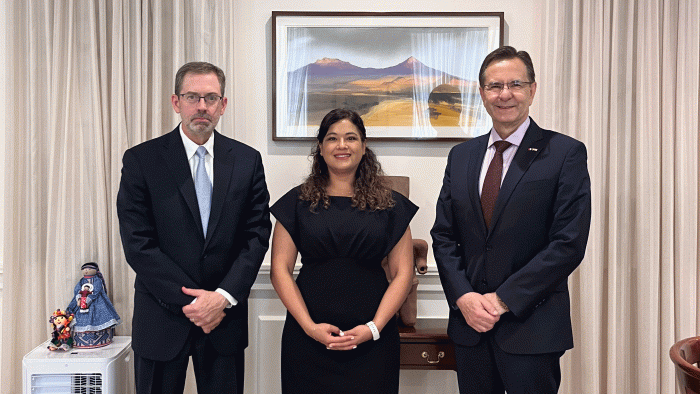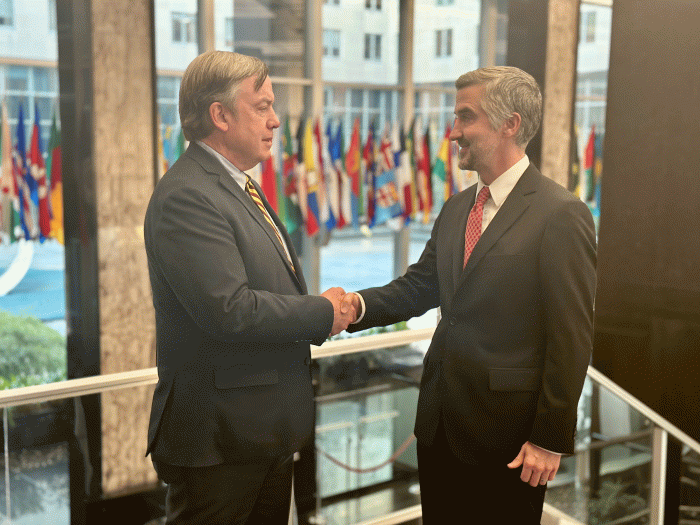Opportunities in ASU-Mexico partnership equip talent for North American microelectronics jobs

Arizona State University President Michael Crow (center) speaks as Esteban Moctezuma Barragán (left), the ambassador of Mexico to the U.S., and Alfonso Durazo Montaño, governor of the state of Sonora, listen before the three sign a memorandum of understanding on Tuesday, Nov. 22, 2022, at the ASU Tempe campus. Cross-border efforts including a technical language course and other workforce development efforts are set to economically benefit people and businesses on both sides of the border. Photo by Charlie Leight/ASU
One country can’t accomplish it all when it comes to the semiconductor or microelectronics sector.
While Arizona is a rapidly expanding hub for revitalizing the industry in the United States, Arizona State University is also working with partners in Mexico to help achieve strategic goals for diversifying the North American semiconductor supply chain.
And it’s already making a difference in the lives of thousands of students and industry workers in Mexico through workshops and industry-specific English language training.
Soon after the CHIPS and Science Act was signed into law in 2022, ASU Mexico Relations began work to establish an institutional partnership with Mexico. Later that same year, ASU and the Embassy of Mexico in the United States signed a memorandum of understanding to promote workforce development, education and collaboration between the university and Mexican institutions working in the semiconductor industry. Sonora Gov. Alfonso Durazo Montaño also signed as a witness of honor.
“I'm thrilled about the collaboration we're having between Arizona State University and the Mexican Embassy in the USA,” said Ambassador Esteban Moctezuma Barragán in a video statement about the latest developments of the work. “... This is our first step of a very, very important partnership and coalition between Arizona State University and the most important academic and governmental agencies in Mexico to build a resilient supply chain of semiconductors.”
This collaborative effort was supported by the Arizona-Mexico Commission with a $200,000 grant to implement the MOU, an investment that helped ASU to determine the immediate institutional strategy for involving different units across the university while beginning to chart the elements for a longer-term strategy, as well.
For the immediate-term action plan, which started in 2023, ASU Mexico Relations worked with ASU Global Launch to develop the online English for the Semiconductor Industry course, and with Global Outreach and Extended Education, part of the Ira A. Fulton Schools of Engineering, to create and deliver two “train the trainer” workshops for faculty from all over Mexico. For these workshops, ASU worked closely with the government of Sonora, as Gov. Durazo’s Sonora Plan serves as a national development strategy coordinating with Mexican agencies to ensure the content complemented Mexico’s capabilities. The technical English course was launched in October at the Embassy of Mexico, and the two workshops were delivered in July in Hermosillo, Mexico, and in December in Tempe, Arizona.
“It was a fast start, and now ASU is developing a second course, focused on microelectronics and nanoelectronics, built in the same environment as the English one, so the learners find it familiar and engage in continued learning,” said Paola Hidalgo, executive director of ASU Mexico Relations. “This course is also part of the MOU implementation, and we plan to launch it this fall with Ambassador Moctezuma, as we envision the next phase of our cooperation.”
These efforts are well-timed to help people learn the necessary skills while the U.S. and Mexico build up their semiconductor industry infrastructure. The Semiconductor Industry Association forecasts a workforce shortage, and efforts such as the ASU-Mexico partnership can help bridge that gap while economically benefiting people and businesses on both sides of the border.
Expanding economic opportunities with English
Regardless of where in the world semiconductor operations take place, English is the standard language for trade and science, making it a crucial skill for anyone interested in working in the field.
The English for the Semiconductor Industry course helps non-native English speakers build this essential skill. The self-paced online course includes an introduction to semiconductor terminology as well as seven modules based on different career interests: design, manufacturing, equipment, safety, supply chain, human resources and finance.
Each module includes vocabulary; pronunciation; reading, writing and listening exercises; quizzes and practice activities; and communication and job application strategies. Participants can choose to take whichever modules align with their goals, or complete the course taking all seven modules.
“ASU has been privileged to work closely with Ambassador Esteban Moctezuma Barragán,” ASU President Michael Crow said. “His background as a former secretary of education and his broad expertise has helped our joint semiconductor education initiatives reach thousands of learners throughout Mexico, and there is much more we can do together.”
Since it launched last October, access to the course has expanded to all 31 Mexican states and Mexico City.
Implementation by partnerships with Mexico’s Ministry of Education via the Tecnológico Nacional de Mexico System, Universidad Autónoma de Baja California and Universidad de Guadalajara has led to more than 10,000 enrollments, representing students, industry professionals and the general public interested in upskilling or reskilling opportunities. These partners created their own MOOCs (massive open online courses) to serve their communities and additional partners including the state of Sonora, the state of Chihuahua and the Universidad Autónoma Metropolitana in Mexico City.
So far, 3,300 participants have completed at least one module and 2,200 have completed the entire course. Universidad Tecmilenio launched its own MOOC recently to be offered to that institution’s engineering students, and Universidad Tecnológica de Altamira will launch it in the near future to serve all the state of Tamaulipas.
The impact is broad, but also very personal.
“The course has been a transformative experience for my understanding and skills in the field,” said Arantxa Villasana, a student in the Institute of Engineering, Master Program at the Universidad Autónoma de Baja California. “In addition to strengthening my grasp of the English language, I improved my pronunciation and understanding of words used in this area. This course not only deepened my technical knowledge of semiconductor manufacturing but also offered valuable insights into management and administration in this critical area.”
More than 350 professionals from electronics manufacturer Skyworks, which has automotive electronics facilities in Mexicali, have taken course modules.
"My experience in the semiconductor course was very enjoyable. I learned new words and more technical concepts of the industry,” said Fernanda Cecilia Herrera, senior financial analyst for Skyworks. “My favorite part was that I was able to relate what the course was showing us with what we actually do at Skyworks, and that made it easier for me to learn the theory.”
Crow said the university’s mission to provide access to education will continue to drive its commitment to help more people have the tools they need to be successful in the rapidly expanding semiconductor industry in North America. University leaders say the entire industry shares the need for talent, and they encourage everyone who is interested to get involved in this opportunity to drive economic growth and employment through new technologies and opportunities in the United States and Mexico.
“A robust semiconductor sector in the Arizona and Mexico corridor means increased economic opportunities for the decades to come,” Hidalgo said. “That’s why ASU and its partners aim to double participation over the next year on this and other courses, bring on additional partners across Mexico, continue to disseminate relevant materials and share best practices to take part of the historic opportunities presented to all of us.”
Expanded cross-border educational collaboration
As part of ASU’s longer-term strategy to bolster this collaboration on semiconductors, ASU competed for funding opportunities that enable a sustained action plan. Global Outreach and Extended Education’s insights and lessons from the train-the-trainers workshops in 2023 led to wider collaborative opportunities with Mexico funded by the U.S. Department of State.
ASU was selected for a two-year, $13.8 million program supported by the International Technology Security and Innovation Fund, or ITSI Fund, created by the CHIPS Act. The program engages governments, semiconductor companies and other key stakeholders to strengthen semiconductor industry resilience in collaboration with partner countries in the Indo-Pacific region and the Americas, including Mexico.
Monique Clement contributed to this story.
More Science and technology

ASU-led space telescope is ready to fly
The Star Planet Activity Research CubeSat, or SPARCS, a small space telescope that will monitor the flares and sunspot activity of low-mass stars, has now passed its pre-shipment review by NASA.…

ASU at the heart of the state's revitalized microelectronics industry
A stronger local economy, more reliable technology, and a future where our computers and devices do the impossible: that’s the transformation ASU is driving through its microelectronics research…

Breakthrough copper alloy achieves unprecedented high-temperature performance
A team of researchers from Arizona State University, the U.S. Army Research Laboratory, Lehigh University and Louisiana State University has developed a groundbreaking high-temperature copper alloy…



